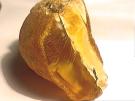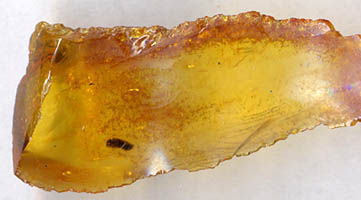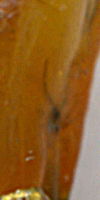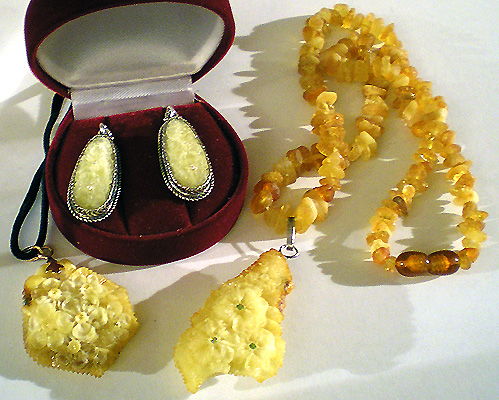Catalogue and magic properties of the stone -->engl
Amber


 Description characteristic of the mineral.
Great defender and conservator, custodian not only from illnesses but also from the most different troubles. Him it is possible very de bene esse to name a stone, as it is hardening resin of prehistoric conifers, to which not alone thousand years. Along with gagatom, tusk of mammoth, amolitom amber behaves to the fossil organogennym minerals.
Description characteristic of the mineral.
Great defender and conservator, custodian not only from illnesses but also from the most different troubles. Him it is possible very de bene esse to name a stone, as it is hardening resin of prehistoric conifers, to which not alone thousand years. Along with gagatom, tusk of mammoth, amolitom amber behaves to the fossil organogennym minerals.
Age most known in the world of Baltic amber makes 35 million years, but there are ambers age of which is exceeded by 100 million years. Among jewellers transparent amber is valued without including of bubbles of air or water. Amber can a color be from transparent to milk, from svetlo-zolotistogo and yellow to practically black. Succinic acid is a biologically-active and medical matter. Getting its houses is possible, insisting an alcohol or vodka on shallow amber to easy pozhelteniya of solution. Amber is very soft and crumbles easily, it is heavy to cut him. Unlike synthetic or epoksidnykh substitutes amber is very easy, it does not sink in the saturated solution of culinary salt. If to amber to touch a burning hot awl, there will be a pleasant smell of rosin and incense. For insertions in precious wares more frequent than all utillize ideal quality the pressed amber. More frequent than all amber is counterfeited a plastic, and these imitations are very successful, before him successfully counterfeited epoksidnymi resins.
Amber knew people since olden times. In burial places and on the stands of ancient people, related to the epoch of late paleolith - neolith, in Pribaltike, Ukraine and in Mediterranean often found amulets, beads, plates and pieces of untilled amber. Workshops on treatment of amber are known from the end of neolith - beginning of bronze age. Succinic trades existed, probably, and on the coast of river Dnepr. They gave material for workshops, being mainly in Kiev. The new bloom of art of treatment of amber behaves to the middle 40th XX century. There were whole artistic directions and schools.
Most widespread and popular Baltic amber is a succinite. Amber appeared in the process of evolution of vegetable cover of Earth. A sharp rise in a temperature caused enhanceable smolootdelenie yantarenosnykh of coniferous plants. Expiration of soft resin here was very intensive and frequent. In the conditions of hot climate the surface of soft resin changed, viscidity had fallen down due to evaporation of terpenics, there was samookislenie of resin acids. This first stage is the stage of hardening of soft resin and increase of its closeness - proceeded hundreds of years. The second stage consisted in the fade of primary composition and properties of matters and intensive decomposition in the conditions of warm and moist climate of dying off wood and bearing-out of its soluble parts waters. The process of fossilizacii went out slowly gradually, and soft resin was covered more young deposits. So there were native deposits of primary amber.
On territory of the Rovenskaya region of Ukraine (CIS) a large deposit was also opened, although the finds of amber in this district were known a long ago. Distributing of amber in a deposit is uneven. Supplies of amber of big. It is far more ancient amber, than Baltic (60-75 million years). On composition and row of properties Ukrainian amber little differs from Baltic.
On the degree of transparency among amber select transparent, semilucent, opaque or translucent in thin skolakh of variety. Often in amber there are including of plants, arthopods classes of spidery (lzheskorpionov, haymakings, spiders and pliers) and insects (shallow types of double-arm and primitive wingless insects) and other Color of amber of zolotisto- or honey-yellow, orange, russet, sometimes black, white (bone and foamy amber), blue and poloschatyy (stratified). Only small part of the obtained amber is suitable for making of jeweller wares. Shallow amber, making 90% general booty, goes to processing: unpolluted - on pressing, other - on the chemical processing (by the method of dry distillation). Pressed amber, or ambroid, along with natural widely utillized in jeweller and kamnereznoy industry. In basis of process the feature of amber is fixed to become plastic at heating to 140-200 With without access of air. The row of methods of making of the pressed amber is known.
For the receipt of more transparent or more light sorts of amber heat treatment is utillized in an autoclave with the subsequent cooling. By such method get the dearest sparkling amber. Similar amber, containing small fan-shaped cracks, creating the additional game of stone, is considered most valuable and inserted in gold wares.

 Magic properties of stone.
Magic properties of stone.
Amber is named magic resin of the ancient forest. The great and magic was consider the pieces of amber, in which insects, sprigs, got in those distant times, leaves and pr. Magicians utillized them in staff and sacred objects. Talisman of inconsolable people which was grasped by grief: it helps a proprietor to be delivered from heavy flashbacks, consoles him and nalazhivaet new life after the series of failures and grief. Amber clears an atmosphere, energetiziruet it, fills with light and gives sold off a hope. It is a very powerful and mysterious stone, and his properties far are not fully investigational.
Amber becomes the talisman of people, aspiring put connections with by the pas, historians, archaeologists, anthropologists and teachers high level. It helps a people put connection of times, connect and synthesize a complete picture, do correct conclusions, daryl ability of exact prognosis of events. Amber - guarded from wicked perfumes, various nezhiti and evil spirits, enemies, ill-wishers and pursuers. A stone is oberegom from lightning and fires, helps travelers, delivering good refuge, and in voyages cares of nepotoplyaemosti of courts. It possesses universal properties to clear space, both soul and body (hymn of Ukraine, CIS - we will give the "Soul and body for our freedom, and will prove that we are brothers - cossack family generation").





Poisonous and radioactive risky hazardous cargo stone and minerals
** - are poisonous stone and minerals (mandatory verification is in the chemical analysis laboratory + on toxicity)
** - are radioactive stone and minerals (mandatory verification on a regular dosimeter + prohibition on the opened sales in the case of radio-activity over 24 milliroentgens / hour + additional measures of protection of people)
All of rare stone are subject obligatory verification on a regular dosimeter on the possible level of radiation and in a chemical laboratory on absence default of poisonous and evaporating components, dangerous for a human people and environment nature
- Free download article Very dangerous and potentially dangerous stone and minerals are in Medical stone therapeutics, with pictures, 2010 year, format of PDF, 2.80 Mb (Presentation from scientific of author K.305 of pictures of very dangerous and potentially dangerous natural stone and minerals which on a bad motive or criminal indifference can be illegally used in criminal and "underground" "Medical stone therapeutics"). Rus langv.
A catalogue of stone is all of stone in alphabetical order
- Signs of travelling traffic lane markings - to transportation and marking of dangerous load Policy Rules
- Rules of Road Transportation of Especially Dangerous Loads, Hazardous cargo commodity, signs index plate
